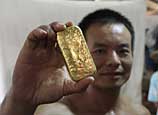
 |
Related:
>> Ming and Qing: Fashionable dynasties
>> Rare chance to see timeless style: Ming and Qing clothing exhibition
Ming Dynasty (1368-1644) clothes belonging to Confucius' aristocratic descendants are among the best-preserved of the era and offer hints of lost textile arts. Zhao Ruixue reports in Jinan.
Despite being more than 500 years old, the silk garments worn by Yansheng dukes - Confucius' direct descendants, honored as nobility - are as well kept as when the aristocrats wore them to meet Ming Dynasty (1368-1644) emperors.
The best-preserved Ming clothing was discovered in two black cases in the Confucius Family Mansion in Qufu, Shandong province. There were about 100 garments. Of these, some 40 articles of Ming clothing and 50 pieces of Qing Dynasty (1644-1911) clothing were donated to the Shandong Provincial Museum between 1954 and 1956.
"Most of the clothing was awarded by emperors. The dukes treasured these like champions treasure gold medals today," says Song Dong, curator of an ongoing exhibition featuring the Ming and Qing nobles' wardrobes in the Shandong Provincial Museum.
The title Yansheng was created as a marquisate during the Western Han Dynasty (206 BC-AD 24). The Song (960-1279) Emperor Renzong (1022-63) raised the 46th-generation descendant of Confucius to the rank of duke. Dukes enjoyed privileges until the Republic of China's founding in 1911.
Duke Yansheng ranked first or second among civil officials during the Ming Dynasty.
The Records for Qufu shows that Ming emperors awarded Yansheng dukes various garments, including court robes, crowns, shoes and jade belts. The dukes cherished these items.
Confucius family members have long highlighted clothing as a crucial component of etiquette. The Confucius Family Mansion employed special servants to care for the clothing.
A servant would take a list of the clothing that the Duke Yansheng couple should wear on a special occasion to another servant who was exclusively responsible for getting the clothing from the wardrobe. There were also servants responsible for maintaining the clothing.
The garments are now kept in a special cabinet with controlled temperature, humidity and illumination ranges. They're displayed on acid-free paper, says Yu Qin, who's responsible for the garments at the museum.
"If we can't preserve the clothing carefully, it will carbonize and disappear," Song says.
"After all, silk is mostly protein."
Ming Tombs Research Society member Cao Jin points out clothes passed down for generations are usually in better condition than those unearthed.
"It took two years for one person to finish such a robe," Cao says, pointing to a mustard-colored silk robe with an embroidered boa exhibited in the museum.
"The robe is so well preserved that you can even see the stitches."
The clothing collection from the Confucius Family Mansion includes perhaps the world's only complete set of Ming court clothing, Song says. But it's not yet known which duke it belonged to. It consists of a five-beamed crown, red silk court robe, red silk skirt, white silk inner garment and a pair of bright red shoes with green lining and cloud patterns.
The crown is the only one of its kind, although its pin and tassel is missing.
Yu Qin, from the museum, says: "Parts of the garments disintegrated when we tried to hang them up."
Song says the most difficult part of restoring Ming clothing is the pigmentation, which was made from Ming-era plants.
"Nobody knows how to make these today," Song says.
















 Breathing and Working Together:Mobile app tells you Beijing's environment
Breathing and Working Together:Mobile app tells you Beijing's environment


![]()
